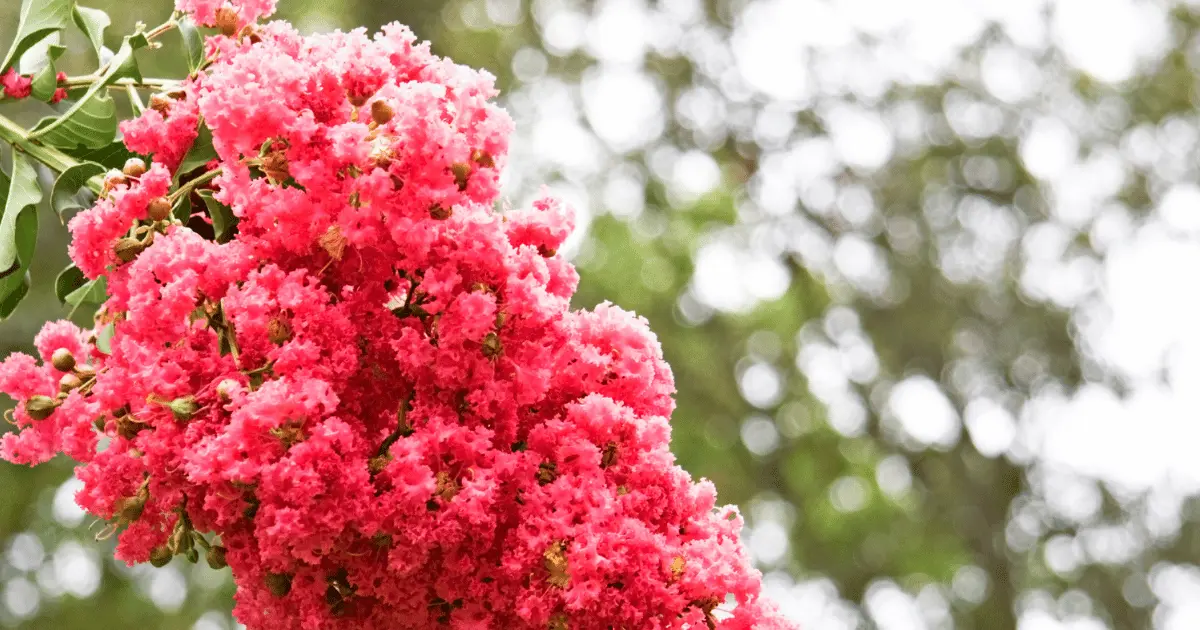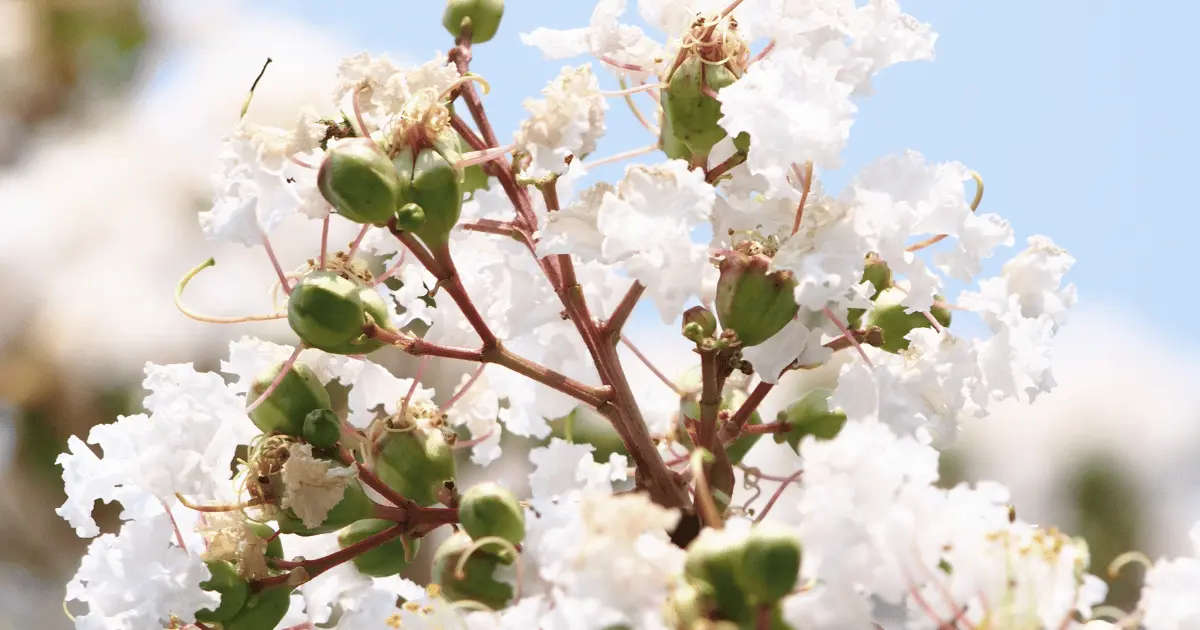The crepe myrtle is a versatile plant that can grow as large as a tree or an ornamental shrub. The flower petals have a crepe-like texture.
Crepe myrtles are mainly grown for their long-lasting, bright, and showy flowers that come in vibrant colors of white, red, purple, and everything in between.
This low-maintenance flowering plant is not only beautiful but a bit diverse. It comes in different sizes ranging from dwarf to towering giants and the deciduous and evergreen varieties.
Crepe myrtles are still breathtaking without their flowers. The foliage changes to yellow, orange, or red in fall, and the peeling bark offers a colorful texture and distinction between the stems and trunks.
Crepe Myrtles Blooming Season

Blooming starts sometime between mid-spring and summer, depending on the variety of crepe myrtle, weather, and planting zone.
Crepe Myrtles thrive on lots of light and a warm climate, so as a result, they tend to flower earliest in warm regions.
For instance, the blooming time, according to different zones, are
- Zone 6: Your crepe myrtle may start to bloom in July through to the first fall frost.
- Zone 7: Crepe myrtles here bloom from late June to early July until the first fall frost.
- Zone 8: Flowering should begin in June and through fall.
- Zone 9: Crepe myrtles bloom from late May to early June through fall.
- Zone 10: In such a zone where frost is uncommon, blooming can begin by mid-May.
Some hybrid varieties have been developed to bloom earlier.
By following this rule, you can calculate your plant’s expected blooming season: Expect leaves a month after the last frost and flowers two months after leaves appear.
How Long Crepe Myrtles Take to Bloom
Crepe myrtles can start blooming anytime from two years after planting. Some can take three to six years to become mature enough to flower.
It all depends on the variety, size, how much you care for it, and the amount of light it receives. Once they start blooming, flowers last for a while.
These shrubs have a lifespan of 25 years minimum but can last more than 50 years if properly taken care of, so you can enjoy your plant for a lifetime.
How Long Crepe Myrtles Blooms Last
All the crepe myrtle trees, shrubs, and bushes produce flowers throughout the summer. Depending on the variety, you can enjoy the blooms for 90-120 days.
Care for a Blooming Crepe Myrtle

Crepe myrtles are relatively low-maintenance, but some specific care instructions are needed to keep them healthy and happy, especially one that blooms.
To help your crepe look its best, always keep it in the sun. For it to continue producing blooms with full color and size, keep your plant under the sun for six hours at the very least.
Ensure the soil is well-draining, as crepe myrtles are susceptible to root rot. Fertilize lightly with slow-growing fertilizer for fuller flowers and healthy growth.
Keep a watchful eye on pests and diseases that may disturb your plant, especially in the summer, and treat them accordingly.
Remove suckers as soon as they appear to maintain a tree shape. Trim them back to the point of origin on the tree, and don’t leave any stub behind.
For large crepe myrtles that shed their bark, calmly gather the sheddings to keep the surroundings neat.
You can deadhead the flowers of the early bloomers to encourage some reblooming later in the season, but this second bloom may not be as show-stopping as the first.
Getting a Crepe Myrtle to Bloom
Crepe myrtle flowering can be hindered by lack of sunlight, poor soil and nutrition, untimely pruning, cold, pests and diseases, and other issues.
Age
Your crepe myrtle may not bloom because it is too young and not mature enough to produce buds.
You might have miscalculated and started expecting flowers too soon, resulting in a panic when they didn’t arrive.
Some varieties take more time than others to bloom, but the flowers will appear.
Insufficient Light
If the light requirements are not met, your crepe myrtle will be hindered with bud development and, ultimately, blooming.
This problem commonly occurs when smaller crepes are grown under tall trees that form canopies with their leaves.
Inadequate Nutrition
Having excess or lacking certain nutrients in your plant’s soil may have a hand in your plant’s failure to bloom.
Phosphorus is the element needed for bud production and development in plants, so an insufficiency will cause failure to blossom.
If you recently fertilized your plant in a bid to boost flowering, it may be that you made a mistake by feeding your plant excess nitrogen.
While nitrogen will boost your plant’s growth, it promotes leaf production at the expense of flower development, leaving you with a non-flowering plant.
Not Enough Water
Crepe myrtles are quite drought-resistant when settled in, but they need constant watering when they are just planted.
A first-time blooming crepe can become stressed and fail to bloom when it does not get enough water.
Untimely Pruning
Crepe myrtles bloom on new wood, and pruning too late in the season removes that new wood, stopping bud development.
You need to know the right time to prune for your plant to flower successfully.
Poor Soil Conditions
If your plant’s soil is soggy and has poor drainage, it is most likely the cause of the absence of flowers.
Crepe myrtles need well-draining soil to be able to grow and flower. Also, while they are not too picky over soil pH, they prefer slightly acidic soil.
Cold Conditions
Your plant will struggle to bloom if you live in a severely cold region or a warm place that experiences a late freeze heading into spring.
Pests and Diseases.
Crepe myrtles are susceptible to various pests like aphids, which suck on the tree sap, making it ooze onto the leaves.
This results in a sticky substance called honeydew covering the plant, causing sooty mold, which is a fungal infection.
These pests and diseases result in stunted bud development, and stalled blooming.
To get your crepe myrtle to bloom, water it regularly to protect it from dehydration and the effects of drought.
Reduce the canopies blocking your plant by pruning the branches of the larger plants to allow more sunshine to reach your plant. You can transfer it to a brighter corner of your garden.
Ensure proper nutrient levels by adding bone meal to the soil around your crepe myrtle to increase phosphorus content. You can mulch the soil to reduce the nitro content.
Prune at the right time in spring before new stems grow to protect the new growth and ensure a full bloom in summer.
Use the right soil for your crepe myrtle, and choose a variety that has the best chance of success in your zone.
You can use insecticidal soap or neem oil to control and get rid of the pests.
